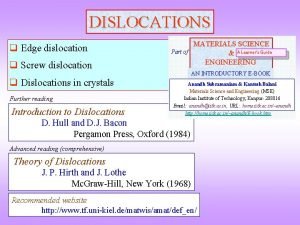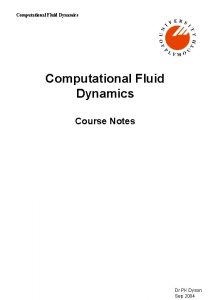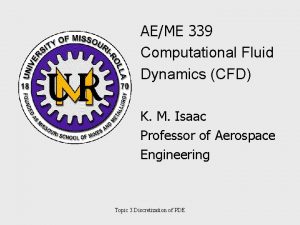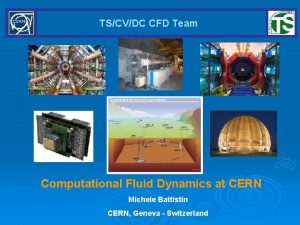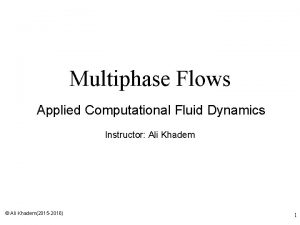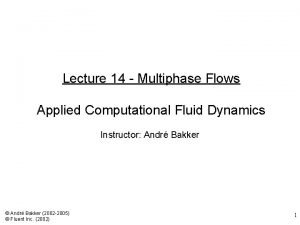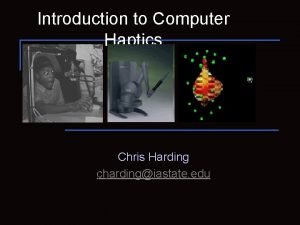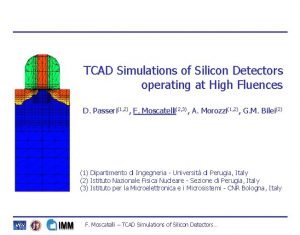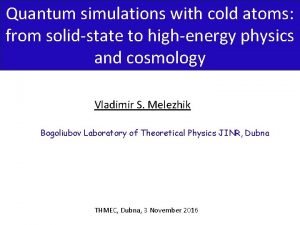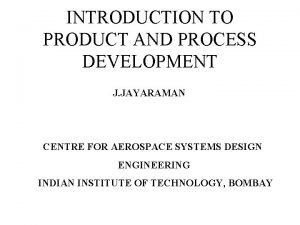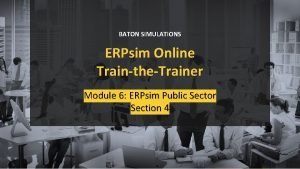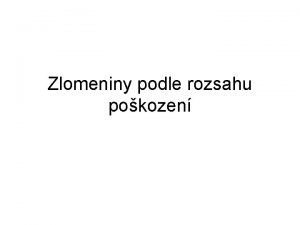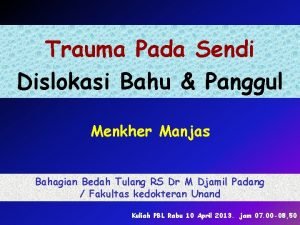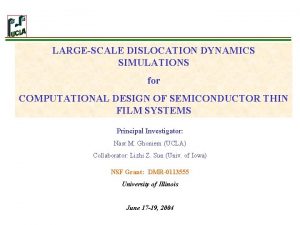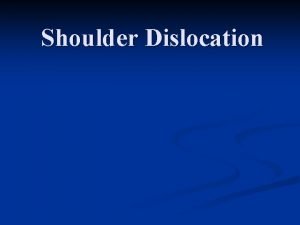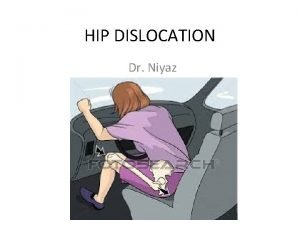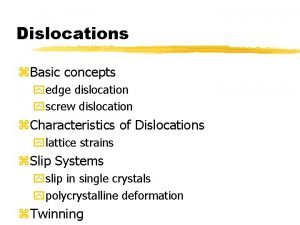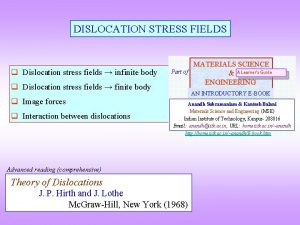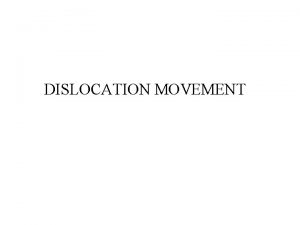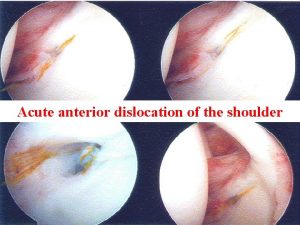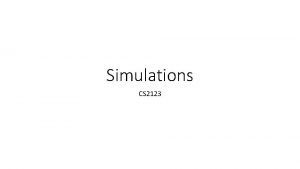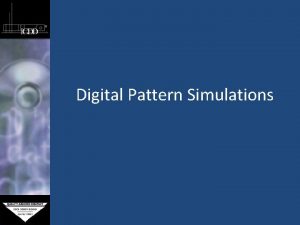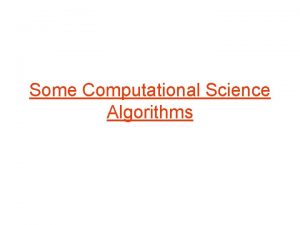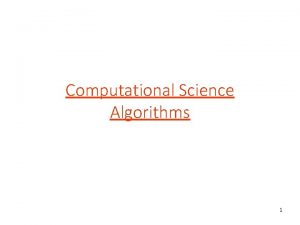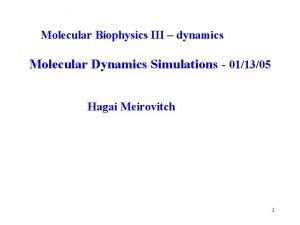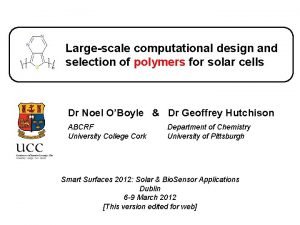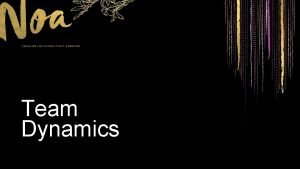LARGESCALE DISLOCATION DYNAMICS SIMULATIONS for COMPUTATIONAL DESIGN OF






![Self-Force Distributions [111] R b [-110] Al (A=1. 21) Cu (A=3. 21) 7 Self-Force Distributions [111] R b [-110] Al (A=1. 21) Cu (A=3. 21) 7](https://slidetodoc.com/presentation_image_h/2011919850d20ea87aaf3dd54f047c13/image-7.jpg)










- Slides: 17

LARGE-SCALE DISLOCATION DYNAMICS SIMULATIONS for COMPUTATIONAL DESIGN OF SEMICONDUCTOR THIN FILM SYSTEMS Principal Investigator: Nasr M. Ghoniem (UCLA) Collaborator: Lizhi Z. Sun (Univ. of Iowa) NSF Grant: DMR-0113555 University of Illinois June 17 -19, 2004

Project Objectives Ø (1) Investigate single and collective dislocation interaction phenomena in anisotropic materials, which determine plasticity and failure of semiconductor devices. Ø (2) Multiscale coupling of the parametric dislocation dynamics with the finite element Ø (3) Develop unique software on parallel, scaleable computer clusters to simulate the collective behavior of topologically complex line defects. Ø (4) Apply the developed software to investigate key dislocation mechanisms. Ø (5) Large-scale simulation and optimization of semiconductor material systems.

Motivation: FEM+DD Superposition is Difficult Many Thin Film Applications Require Mutilayers of Anisotropic Materials (Poly, or single crystal) 10 a from z = 10000 a boundary scale factor = 1 50 a from z = 10000 a boundary scale factor = 10 250 a from z = 10000 a boundary scale factor = 10 Figure 5. 4. 2. 3: Image force distributions for a 2000 a radius loop at different distances from the z=10000 a boundary. Scale factors as indicated. 3

Dislocation in Anisotropic Materials The field of a dislocation loop in a non-homogeneous solid:

Dislocations in Anisotropic Multilayer Materials

Peach-Koehler Force Distributions y R b d x b 2 Forces divided by 0. 5(C 11 -C 12)bb 2/R , d=1. 5 R 6
![SelfForce Distributions 111 R b 110 Al A1 21 Cu A3 21 7 Self-Force Distributions [111] R b [-110] Al (A=1. 21) Cu (A=3. 21) 7](https://slidetodoc.com/presentation_image_h/2011919850d20ea87aaf3dd54f047c13/image-7.jpg)
Self-Force Distributions [111] R b [-110] Al (A=1. 21) Cu (A=3. 21) 7

Dislocation Dynamics -Dipole Breakup 11/ =0. 1% 11/ =0. 12% (Resolved shear stress is 0. 04%) (Resolved shear stress is 0. 05%) ( =(C 11 -C 12)/2 ) 8

Results of Large Scale Simulation (cont. )

Results of Large Scale Simulation (cont. )

Strain Hardening in Cu

The stress field of dislocation loop in a thin film - Peach-Koehler force due to interface [001] [100] [010] Al (film)-Cu (half space) [100] Ni (film)-Cu (half space)

Dislocation Motion with Interface Image Forces, ~ 30 nm < h < ~ 200 nm Critical Stress= 250 MPa Film thickness, h=144 nm Above critical stress - Biaxial stress=280 MPa

Critical Stress with Anisotropy & Image Forces

Deformation Modes in Multilayer Thin Films PI CLS I II HP III QE IV

Conclusions Ø Elastic anisotropy results in unexpected effects (e. g. dislocation climb, dipole & F-R source stability). Ø Larger values of the anisotropy ratio (A) results in an “equivalent” larger self-force. Ø Equivalent isotropic elastic constants do not result in equivalent strain hardening. Ø A method has been established to satisfy all interface & free surface B. C’s in anisotropic thin films. Ø Loops develop climb forces near interfaces. Ø Good agreement with experiments on nano-indentation.

Publications & Activities Ø 1. X. Han, N. M. Ghoniem and Z. Wang, “Parametric Dislocation Dynamics of Anisotropic Crystals, ” Phil Mag. , Vol. 83, Nos. 31– 34, 2004. Ø 2. N. M. Ghoniem, E. Busso, and N. Kioussis, “Multiscale modelling of nanomechanics and micromechanics: an overview, ” Phil Mag. , Vol. 83, Nos. 31– 34, 3475– 3528, 2004. Ø 3. J. Huang, N. M. Ghoniemy and J. Kratochv, “On the Sweeping Mechanism of Dipolar Dislocation Loops Under Fatigue Conditions, MSMSE, 2004. Ø 4. Zhiqiang Wang, Rodney J. Mc. Cabe, Nasr M. Ghoniem, Richard Le. Sar, Amit Misra; and Terence E. Mitchel, “Dislocation Motion in Thin Cu foils: A Comparison Between Computer Simulations and Experiment, “ Acta Mater. , 2004. Ø 5 Nasr M. Ghoniem, and Nicholas Kioussis. “Hierarchical Models of Nano and Micro-Mechanics, ” Chapter in Encyclopedia of Nano Science & Technology, American Publishers, In Press.
 Edge dislocation and screw dislocation
Edge dislocation and screw dislocation Fluid dynamics
Fluid dynamics Computational fluid dynamics
Computational fluid dynamics Computational fluid dynamics
Computational fluid dynamics Computational fluid dynamics
Computational fluid dynamics Computational fluid dynamics
Computational fluid dynamics Ideal gas vs perfect gas
Ideal gas vs perfect gas Yes or no
Yes or no Clinical simulations in nursing education
Clinical simulations in nursing education Chris harding simulations
Chris harding simulations Tcad simulations
Tcad simulations World history simulations
World history simulations Simulations for solid state physics
Simulations for solid state physics Payroll card
Payroll card Key tenets of ippd
Key tenets of ippd Baton simulations
Baton simulations Dislocation ad axim
Dislocation ad axim Stimson method
Stimson method
